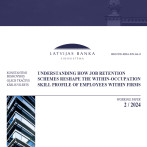Moderation in economic growth also affects labour market

Currently, Latvia's labour market tends to follow the trend of moderation in the annual economic growth. In the first half of the year, we already projected that the labour market developments will be affected by economic growth this year.
Following a slowdown at the beginning of the year, GDP recorded growth in the second quarter, and both GDP and labour market indicators are expected to continue to follow similar growth trends at least by the end of the year.
According to the data released by the Central Statistical Bureau of Latvia, Latvia's unemployment rate declined to 6.4% in the second quarter of 2019. Compared to the first quarter, the number of the employed increased by two thousand to 905.6 thousand, while that of the unemployed decreased by 5.4 thousand. This situation is possible due to a decline in the economically active population. Prima facie, one might think that labour market indicators only reflect demographic trends. However, we should keep in mind some important details.
The labour market is highly seasonal; therefore, it is essential to compare its indicators over a longer period of time. For instance, although the number of the employed has picked up in quarterly terms, it has recorded a 0.44% decline compared with the second quarter of 2018. While this may not seem like much, it should be noted that a quarterly year-on-year decrease in employment had not been observed since the second quarter of 2017, and since then the number of the employed had been growing by 1.3% on average.
Moreover, it should be taken into account that in the recent years the number of the employed is rising. Nonetheless, the number of the employed, which amounted to 905.6 thousand in the second quarter of 2019, is lower compared to the previous year's average. Of course, the number of the employed might still increase notably by the end of the year. However, over the last five years, the employment indicators of the second quarter have usually been higher than the respective average of the year (except for the second quarter of 2017 mentioned above). This suggests that the moderation in the economic growth has also affected the growth rate of the labour market. Since the economic growth is unlikely to bring any positive surprises this year, the labour market is also expected to see only moderate growth.
Moreover, the 6.4% unemployment rate only represents the average labour market temperature. For instance, when looking across age groups, unemployment rates vary from 4.9% in the 45–54 year age group to 15.1% in the 15–24 age group. While the overall number of the unemployed is declining, some age groups have recorded an increase suggesting that, at the moment, not all job seekers can find a desirable or suitable job.
Employment indicators also show various trends across sectors. For instance, the number of occupied posts in the manufacturing sector seems to have remained broadly unchanged from the beginning of 2018 until the first quarter of 2019, with each quarter recording annual growth of less than 1% (the second quarter data will be available in September). In the breakdown by subsector, however, it is evident that nine of 32 subsectors have seen a decline in the number of their occupied posts each quarter, and the number of the occupied posts has decreased on average in almost half of the subsectors during the above period. Hence, other subsectors recorded an increase.
This means that the labour market is active, and labour moves between sectors. This may be caused by a decline in labour demand in a sector or by an increase in the respective demand in another sector that can offer more attractive employment conditions to employees, i.e. higher wages, more favourable working hours or additional benefits. Since the number of the unemployed is decreasing, we can conclude that the second case is currently predominant. However, where additional workforce is not accompanied by a rise in productivity, businesses incur extra costs which, consequently, drive up their production costs. As a result, even the most attractive employers may lose their competitiveness over time (in current circumstances in particular).
This reminds us once again: while attracting labour, a business should also develop a productivity improvement strategy to maintain its competitiveness.
Textual error
«… …»




